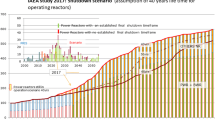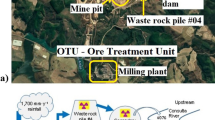Abstract
The release of liquid effluents containing radionuclides from radioactive plants in urban areas has been the subject of discussions related to the environmental issue. This study presents the analysis of the activity concentrations (AC) of 131I and 99mTc in sewage samples collected in a nuclear medicine facility (NMF), associated with an university hospital situated in Rio de Janeiro, Brazil. The analyzes and measurements by gamma spectrometry of the collected sewage samples were performed, whose the estimated values (EV) for AC obtained for 131I in July (8.78 × 103 Bq m-3) and September 2016 (9.80 × 103 Bq m-3) and in February 2017 (1.14 × 104 Bq m-3) were lower than the exemption level (EL = 1.90 × 104 Bq m-3). For 99mTc, the EV for AC obtained from August (4.77 × 102 Bq m-3 and 2.96 × 104 Bq m-3) to September 2017 (2.18 × 103 Bq m-3) were lower than the EL (1.90 × 109 Bq m-3). From an environmental point of view, the presence of 131I in the sewage treatment unit (STU), even if below the legal release limit, points out the greater importance of this radionuclide, as it requires special precautions in its adequate storage for the radioactive decay in the NMF and the dilution effect to reduce its AC minimizing the environmental impact after the effluent release to the environment. The presence of 131I in the STU was not expected pointing to the need and evaluation of the waste management system (WMS) of the NMF.
Similar content being viewed by others
Data Availability
Not applicable.
References
ARPANSA (Australian Radiation Protection and Nuclear Safety Agency). (2015). Radiation Protection of the environment – Guide G1. Victoria, Australia.
Barquero, R., Agulla, M. M., & Ruiz, A. (2008). Liquid discharges from the use of radionuclides in medicine (diagnosis). Journal of Environmental Radioactivy, 99(10), 1535–1538. https://doi.org/10.1016/j.jenvrad.2007.12.009.
Birks, J. L. (1975). Medical radionuclides in marine environment. Nature, 255, 621–622.
Carolan, J. V., Hughes, C. E., & Hoffmann, E. L. (2011). Dose assessment for marine biota and humans from discharge of 131I to the marine environment and uptake by algae in Sydney, Australia. Journal of Environmental Radioactivy, 102, 953–963. https://doi.org/10.1016/j.jenvrad.2009.10.002.
CNEN (Comissão Nacional de Energia Nuclear). (2005). Posição Regulatória-3.01/007:2005 – Níveis de Intervenção e de Ação para Exposição Crônica. Rio de Janeiro, RJ, Brasil (in Portuguese).
CNEN (Comissão Nacional de Energia Nuclear). (2011). Posição Regulatória-3.01/001:2011 – Critérios de Exclusão, Isenção e Dispensa de Requisitos de Proteção Radiológica. Rio de Janeiro, RJ, Brasil (in Portuguese).
CNEN (Comissão Nacional de Energia Nuclear). (2013). Norma CNEN-NN-3.05: Requisitos de Segurança e Proteção Radiológica para Serviços de Medicina Nuclear. Resolução CNEN 159/13, 2013. In Rio de Janeiro. Brasil: RJ (in Portuguese).
CNEN (Comissão Nacional de Energia Nuclear). (2014). Norma CNEN-NN-8.01: Gerência de Rejeitos Radioativos de Baixo e Médio Níveis de Radiação – Resolução CNEN 167/2014. Rio de Janeiro,. RJ, Brasil (in Portuguese).
Fischer, H. W., Ulbrich, S., Pittauerová, D., & Hettwig, B. (2009). Medical radioisotopes in the environment – following the pathway from patient to river sediment. Journal of Environmental Radioactivy, 100, 1079–1085. https://doi.org/10.1016/j.jenvrad.2009.05.002.
Goddard, C. (1999). The use of delay tanks in the management of radioactive waste from thyroid therapy. Nuclear Medicine Communitations, 20(1), 85–94.
IAEA (International Atomic Energy Agency). (2014). IAEA safety standards – radiation protection and safety of radiation sources: international basic safety standards, General Safety Requirements Part 3, No. GSR Part 3. Planned Exposure Situations. 29. Austria: Printed by the IAEA in Vienna.
IAEA (International Atomic Energy Agency). (2018a). Radiation protection and safety in medical uses of ionizing radiation – specific safety guide no, SSG-46. Vienna: Austria.
IAEA (International Atomic Energy Agency). (2018b). Regulatory control of radioactive discharges to the environment – IAEA general safety guide no, GSG-9. Vienna: Austria.
IAEA (International Atomic Energy Agency). (2018c). Prospective radiological environmental impact for facilities and activities – IAEA general safety guide no, GSG-10. Vienna: Austria.
ICRP (International Commission on Radiological Protection). (2004). Release of patients after therapy with unsealed radionuclides. ICRP Publication 94. Annals of the ICRP 34 (2). Elsevier.
ICRP (International Commission on Radiological Protection). (2007). The 2007 recommendations of the international commission on radiological protection. ICRP Publication 103. Annals of the ICRP 37 (2-4), Elsevier.
ICRP (International Commission on Radiological Protection). (2009). Environmental protection: transfer parameters for reference animals and plants. ICRP Publication 114. Annals of the ICRP 39(6). Elsevier.
ICRP (International Commission on Radiological Protection). (2017). Dose coefficients for non-human biota environmentally exposed to radiation. ICRP Publication 136. Annals of the ICRP 46 (2). SAGE.
ISO (International Organization for Standardization). (2007). ISO 10703:2007 – Water quality – determination of the activity concentration of radionuclides – method by high resolution gamma-ray spectrometry.
ISO (International Organization for Standardization). (2010). ISO 11929:2010 – Determination of characteristic limits (decision threshold, detection limit and limits of the confidence interval) for measurements of ionizing radiation – fundamentals and applications.
Jiménez, F., Debán, L., Pardo, L., López, R., & García-Talavera, M. (2011). Levels of 131I and Six Natural Radionuclides in Sludge from the Sewage Treatment Plant of Valladolid, Spain. Water, Air, and Soil Pollution, 217, 515–521. https://doi.org/10.1007/s11270-010-0605-8.
Krawczyk, E., Piñero-Garcia, F., & Ferro-Garcia, M. A. (2013). Discharges of nuclear medicine radioisotopes in Spanish hospitals. Journal of Environmental Radioactivy, 116, 93–98. https://doi.org/10.1016/j.jenvrad.2012.08.011.
L’Annunziata, M. F. (2012). Handbook of Radioactive Analysis (3rd ed.). Academic Press.
Lee, U., Kim, M. J., & Kim, H. R. (2018). Radioactive iodine analysis in environmental samples around nuclear facilities and sewage treatment plants. Nuclear Engineering and Technology, 50, 1355–1363. https://doi.org/10.1016/j.net.2018.07.017.
Martínez, J., Peñalver, A., Baciu, T., Artigues, M., Danús, M., et al. (2018). Presence of artificial radionuclides in samples from potable water and wastewater treatment plants. Journal of Environmental Radioactivy, 192, 187–193. https://doi.org/10.1016/j.jenvrad.2018.06.024.
Moss, C. E. (1973). Control of of radioisotope releases to the environment from diagnostic isotope procedures. Health Physics, 71, 197–198.
Mundschenk, H. (1996). Occurence and behaviour of radionuclides in the Moselle River – part I: entry of natural and artificial radionuclides. Journal of Environmental Radioactivy, 30(3), 199–213. https://doi.org/10.1016/0265-931X(95)00009-Y.
Ninkovic, M. M., & Androvic, F. (2005). Chapter 1 (pp. 3–19). Gamma Radiation: Air kerma rate constants for nuclides important to gamma ray dosimetry and practical application. In. https://doi.org/10.5772/39170.
Ravichandran, R., Binukumar, J. P., Sreeram, R., & Arunkumar, L. S. (2011). An overview of radioactive waste disposal procedures of a nuclear medicine department. Journal of Medical Physics, 36(2), 95–99. https://doi.org/10.4103/0971-6203.79692.
Rose, P. S., Swanson, R. L., & Cochran, J. K. (2012). Medically-derived 131I in municipal sewage effluent. Water Research, 46, 5663–5671. https://doi.org/10.1016/j.watres.2012.07.045.
Soares, J. A. (2019). Protocolos Cintilográficos do Sistema Nervoso (title in Portuguese), BSc Monography in Radiological Technology. Instituto Federal de Educação, Ciência e Tecnologia de Santa Catarina. SC, Brazil: Florianópolis.
SSK (Strahlenschutzkommission). (2004). Ermittlung der VorbelastungdurchRadionuklid-Ausscheidungen von Patient der Nuklearmedizin. Bonn: Empfehlung der Strahlenschutzkommission (in German).
Sundell-Bergman, S., de la Cruz, I., Avila, R., & Hasselblad, S. (2008). A new approach to assessment and management of the impact from medical liquid radioactive waste. Journal of Environmental Radioactivy, 99(10), 1572–1577. https://doi.org/10.1016/j.jenvrad.2007.12.005.
UNEP (United Nations Environment Programme). (2016). Radiation effects and sources: what is radiation? What does radiation do to us? Where does Radiation Come From? New York, 10.18356/b1749f17-en.
Acknowledgements
The authors are grateful for the financial support of the Carlos Chagas Filho Foundation for Research in the State of Rio de Janeiro (FAPERJ) and the National Council for Scientific and Technological Development (CNPq) and to Alexandre Rodrigues (COTAR-X/UFRJ), José Marques, Jardel Thalhofer, Leandro Barbosa, Ricardo Garcêz, Alessandro Domingues, and Rogério Filgueiras (LAASC/PEN/COPPE/UFRJ) for the logistic cooperation to carry out this study.
Code availability
Not applicable.
Funding
The two funding regardings who supported the development of this study were: Carlos Chagas Filho Foundation for Research in the State of Rio de Janeiro (FAPERJ) and the National Council for Scientific and Technological Development (CNPq).
Author information
Authors and Affiliations
Contributions
Not applicable.
Corresponding author
Ethics declarations
Conflict of interest
Not applicable.
Additional information
Publisher’s Note
Springer Nature remains neutral with regard to jurisdictional claims in published maps and institutional affiliations.
Rights and permissions
About this article
Cite this article
do Carmo, A.S., Vianello, E.A., Pereira, W. et al. 131I and 99mTc in Effluents from a Nuclear Medicine Facility and Associated Sewage Treatment Unit. Water Air Soil Pollut 232, 130 (2021). https://doi.org/10.1007/s11270-021-05076-5
Received:
Accepted:
Published:
DOI: https://doi.org/10.1007/s11270-021-05076-5




